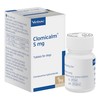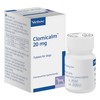Clomicalm
Clomicalm Tablets for Dogs can be used as an aid in the treatment of separation-related disorders manifested by inappropriate elimination such as defaecation and urination, or destruction. They should only be used in combination with behavioural modification techniques.
Clomicalm Tablets are presented as brownish-grey oval to oblong tablets that have been scored on both sides so that they can be divided for easy and accurate dosing.
Clomicalm 5mg Tablets for Dogs
£2.68Clomicalm 5mg Tablets are indicated for use as an aid in the treatment of separation-related disorders in dogs manifested by destruction and inappropriate elimination (defaecation and...[More info]
Clomicalm 20mg Tablets for Dogs
£0.34Clomicalm 20mg Tablets are indicated for use as an aid in the treatment of separation-related disorders in dogs manifested by destruction and inappropriate elimination (defaecation and...[More info]
Contraindications
Do not use in case of known hypersensitivity to clomipramine and related tricyclic antidepressants. Do not use in male breeding dogs.
Special warnings for each target species
The efficacy and safety of Clomicalm has not been established in dogs weighing less than 1.25 kg or under six months of age.
Special precautions for use
Special precautions for use in animals: It is recommended that Clomicalm be administered to dogs with cardiovascular dysfunction or epilepsy with caution and only after an assessment of the benefit risk ratio. Because of its potential anticholinergic properties, Clomicalm should also be used with care in dogs with narrow angle glaucoma, reduced gastrointestinal motility or urinary retention. Clomicalm should be used under veterinary supervision.
Special precautions to be taken by the person administering the veterinary medicinal product to animals:
In children, accidental ingestion should be regarded as serious. There is no specific antidote. In case of accidental ingestion, seek medical advice immediately and show the product label to the physician. Overdose in human beings causes anticholinergic effects although central nervous and cardiovascular systems may also be affected. People with known hypersensitivity to clomipramine should administer the product with caution.
Adverse reactions (frequency and seriousness)
Clomicalm may very rarely cause vomiting, changes in appetite, lethargy or an elevation in liver enzymes, which is reversible when the product is discontinued. Hepato-biliary disease has been reported, especially with pre-existing conditions, and concurrent administrations of drugs metabolized via the hepatic system. Vomiting may be reduced by co-administration of Clomicalm with a small quantity of food.
The frequency of adverse reactions is defined using the following convention:
-very common (more than 1 in 10 animals treated displaying adverse reaction(s))
-common (more than 1 but less than 10 animals in 100 animals treated)
-uncommon (more than 1 but less than 10 animals in 1,000 animals treated)
-rare (more than 1 but less than 10 animals in 10,000 animals treated)
-very rare (less than 1 animal in 10,000 animals treated, including isolated reports)
Use during pregnancy, lactation or lay
The safety of the veterinary medicinal product has not been established in female dogs during pregnancy and lactation.
Pregnancy: Laboratory studies in mice and rats have shown evidence of embryotoxic effects.
Interaction with other medicinal products and other forms of interaction
Recommendations on the interaction between Clomicalm and other medicaments are derived from studies in species other than dogs. Clomicalm may potentiate the effects of the anti-arrhythmic drug quinidine, anticholinergic agents (e.g. atropine), other CNS active drugs (e.g. barbiturates, benzodiazepines, general anaesthetics, neuroleptics), sympathomimetics (e.g. adrenaline) and coumarin derivatives. The administration of Clomicalm is not recommended in combination with, or within 2 weeks of therapy with, monoamine oxidase inhibitors. Simultaneous administration with cimetidine may lead to increased plasma levels of clomipramine. Plasma levels of certain anti-epileptic drugs, such as phenytoin and carbamazepine, may be increased by co-administration with Clomicalm.
Amounts to be administered and administration route
Clomicalm should be administered orally at a dose of 1-2 mg/kg clomipramine twice daily to give a total daily dose of 2-4 mg/kg
Clomicalm may be given with or without food. In clinical trials, a treatment time of 2-3 months with Clomicalm in combination with behavioural modification techniques was sufficient to control the symptoms of separation-related disorders. Some cases may require longer treatment. In cases showing no improvement after 2 months, treatment with Clomicalm should be ceased.
Overdose (symptoms, emergency procedures, antidotes), if necessary
At overdose with 20 mg/kg Clomicalm (5 times the maximum therapeutic dose), bradycardia and arrhythmias (atrioventricular node block and ventricular escape beats) were observed approximately 12 hours after dosing. Overdose with 40 mg/kg (20 times the recommended dose) of Clomicalm produced hunched posture, tremors, flushed abdomen and decreased activity in dogs. Higher doses (500 mg/kg i.e. 250 times the recommended dose) produced emesis, defecation, drooped eyes, trembling and quietness. Still higher doses (725 mg/kg) produced, in addition, convulsions and death.
Pharmacological particulars
Pharmacotherapeutic group: Non-selective monoamine re-uptake inhibitors,
ATCvet code: QN06AA04.
5.1 Pharmacodynamic properties
Clomipramine has a broad-spectrum of action in blocking the neuronal reuptake of both serotonin (5-HT) and noradrenaline. It therefore possesses the properties of a serotonin re-uptake inhibitor and a tricyclic antidepressant.
The active components in vivo are clomipramine and its major metabolite, desmethylclomipramine. Both clomipramine and desmethylclomipramine contribute to the effects of Clomicalm: clomipramine is a potent and selective 5-HT reuptake inhibitor while desmethylclomipramine is a potent and selective noradrenaline reuptake inhibitor. The principle mechanism of action of clomipramine is potentiation of the effects of 5-HT and noradrenaline in the brain by inhibiting their neuronal reuptake. In addition, clomipramine has anticholinergic effects by antagonism of cholinergic muscarinic receptors.
5.2 Pharmacokinetic particulars
Clomipramine is well absorbed (>80%) from the gastrointestinal tract in dogs when administered orally but the systemic bioavailability for clomipramine and desmethylclomipramine is 22-26% due to extensive first pass metabolism by the liver. Peak plasma levels of clomipramine and desmethylclomipramine are rapidly reached (approx. 1.5-2.5 hours). The maximal plasma concentrations (Cmax) after oral administration of single doses of 2 mg/kg clomipramine hydrochloride were: 240 nmol/l for clomipramine and 48 nmol/l for desmethylclomipramine. Repeated administration of Clomicalm causes moderate increases in plasma concentrations, accumulation ratios after oral administration twice daily were 1.2 for clomipramine and 1.6 for desmethylclomipramine, with steady state being reached within 3 days. At steady state, the ratio of plasma clomipramine to desmethylclomipramine concentrations is approximately 3:1. Administration of Clomicalm with food causes moderately higher plasma AUC values for clomipramine (25%) and desmethylclomipramine (8%) as compared with administration to fasted dogs. Clomipramine is extensively bound to plasma proteins (>97 %) in dogs. Clomipramine and its metabolites are rapidly distributed in the body in mice, rabbits, and rats with high concentrations being achieved in organs and tissues (including the lungs, heart and brain) and low concentrations remaining in the blood. In dogs, the volume of distribution (VDss) is 3.8 l/kg. The major route of biotransformation of clomipramine is demethylation to desmethylclomipramine. Additional polar metabolites also exist. The elimination t1/2 after intravenous administration of clomipramine hydrochloride in dogs was 6.4 hours for clomipramine and 3.6 hours for desmethylclomipramine. The principle route of excretion in dogs is via the bile (>80%) with the remainder via the urine.
Pharmaceutical particulars
List of excipients: Lactose monohydrate, Microcrystalline cellulose, Artificial meat flavour, Crospovidone, Povidone, Colloidal anhydrous silica, Magnesium stearate
Shelf-life of the veterinary medicinal product as packaged for sale: 4 years
Store in the original container.
Nature and composition of immediate packaging - One HDPE bottle with child resistant closure and sealing disk, containing 30 tablets and one silica gel desiccant sachet, packed within a cardboard box.
Any unused veterinary medicinal product or waste materials derived from such veterinary medicinal product should be disposed of in accordance with local requirements.

